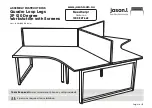
9
DPAS-2100
99922205734
© 08/2021 ECHO Incorporated
SAFETY
• binding of moving parts, breakage of parts and any other condition
that may affect the power tool's operation. If damaged, have the
power tool repaired before use.
Many accidents are caused by poorly
maintained power tools.
•
Keep cutting tools sharp and clean.
Properly maintained cutting tools
with sharp cutting edges are less likely to bind and are easier to control.
• Use the power tool and accessories in accordance with these
instructions, taking into account the working conditions and the
work to be performed.
Use of the power tool for operations different from
those intended could result in a hazardous situation.
• Keep handles and grasping surfaces dry, clean and free from oil and
grease.
Slippery handles and grasping surfaces do not allow for safe
handling and control of the tool in unexpected situations.
Battery Tool Use and Care
•
Recharge only with ECHO eFORCE™ 56V battery series chargers.
A charger that is suitable for one type of battery may create a risk of fire
when used with another battery.
•
Use only with ECHO eFORCE™ 56V battery series.
Use of any other
batteries may create a risk of injury and fire.
• When battery is not in use, keep it away from other metal objects like
paper clips, coins, keys, nails, screws, or other small metal objects
that can make a connection from one terminal to another.
Shorting the
battery terminals together may cause burns or fire.
•
Do not open or destroy the battery.
Electrolytes contained within the
battery are corrosive and may cause damage to eyes or skin if released. It
may be toxic if swallowed.
•
Under abusive conditions, liquid may be ejected from the battery;
avoid contact. If contact accidentally occurs, flush with water. If
liquid contacts eyes, additionally seek medical help.
Liquid ejected
from the battery may cause irritation or burns.
• Exercise care in handling batteries to avoid shorting the battery with
conducting materials such as rings, bracelets, keys, etc.
The battery
or conductor may overheat and cause burns if contact with said materials
is made.
•
Do not use a battery or tool that is damaged or modified.
Damaged
or modified batteries may exhibit unpredictable behavior resulting in fire,
explosion or risk of injury.
•
Do not expose a battery or tool to fire or excessive temperature.
Exposure to fire or temperature above 266 °F (130 °C) may cause
explosion.
• Follow all charging instructions and do not charge the battery or tool
outside the temperature range specified in the instructions.
Charging
improperly or at temperatures outside the specified range may damage
the battery and increase the risk of fire.










































